
Why Understanding Your Application Usage Is Key to Begin Optimizing SaaS
Table of Contents ToggleWhy SaaS Optimization Is Important Companies Spend a Lot...
Back
Back
Search for Keywords...
Blog

Table of Contents
Optimization, by its very definition, is the process by which we attempt to make the most effective or best use of something. It’s the improvement of our daily activities and lives. We’re always optimizing.
Maybe optimization in your life looks like budgeting out your monthly expenses, finding the fastest route to work, organizing your favorite websites into a single folder, or knowing the convenience store with the nicest staff. It’s the thing that saves you time and hassle.
When it comes to SaaS, optimization is about making the most of your investment in tools for your business. This happens in a couple of different ways:
SaaS optimization covers a broad range of things like managing and taking action on spend, vendor negotiations and renewals, rationalization, and the management of licenses and users. All of which carry the potential to cost your company time and money if done improperly.
All SaaS optimization requires visibility into the applications your company is utilizing. You cannot take action until you know what your estate looks like. This process of figuring that out is SaaS discovery and it’s the first step in the process of SaaS optimization.
SaaS optimization is one of the most important elements of business that a company can focus on. This is due to a variety of factors but the most important are:
According to Zylo’s 2025 SaaS Management Index, the average organization has 275 applications in its portfolio. This number translates to an average spend of $49M on SaaS alone each year.
Many of these applications renew automatically if left alone, giving them the potential to continue charging the company long after outliving their usefulness.
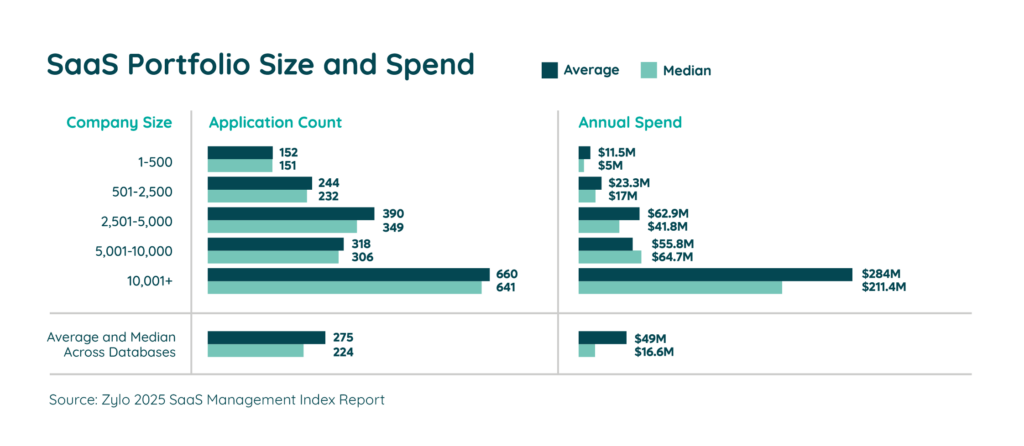
Today, anyone can sign up for an application and expense it to their company. The role of IT procurement and management has undergone a complete shift as a result. As such, it creates new challenges and opportunities around optimization.
With the current state of affairs, IT manages just 16% of applications, while lines of business and individuals make up the remaining 84%. This decentralized purchasing is a major cause of SaaS sprawl – an increasing spread of applications and spend in the tech stack.
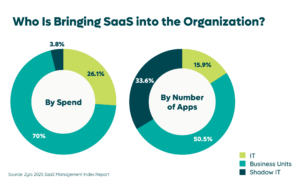
The factors above contribute greatly to the meteoric rise in SaaS purchases. This increase in the number of applications a company uses has not led to a higher amount of utilization, however. In other words, we keep adding tools to the toolbox but we aren’t using many of them.
How much is actually being wasted on SaaS?
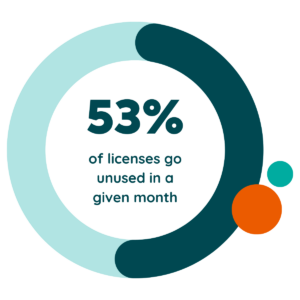 In fact, the average organization is only using 47% of its provisioned licenses. That leaves a staggering 53% ripe for optimization — up from 44% in 2022.
In fact, the average organization is only using 47% of its provisioned licenses. That leaves a staggering 53% ripe for optimization — up from 44% in 2022.
So, more isn’t always better but, how many apps are too many?
That depends on your organization and the goals you have for it. No two businesses are going to be the same, no matter how similar they are. Still, regardless of who you are and where you’re at, we always think there’s an opportunity to do better.
Here’s why:
Managing your SaaS spend is one way to be a good steward of your company’s money. License management and SaaS subscription management can revolutionize the budget of your business.
Decreasing spend isn’t only about boosting the bottom line, though. It also assists greatly in budgeting your line items and funding projects that your company wants to focus on.
Who doesn’t love to save money?
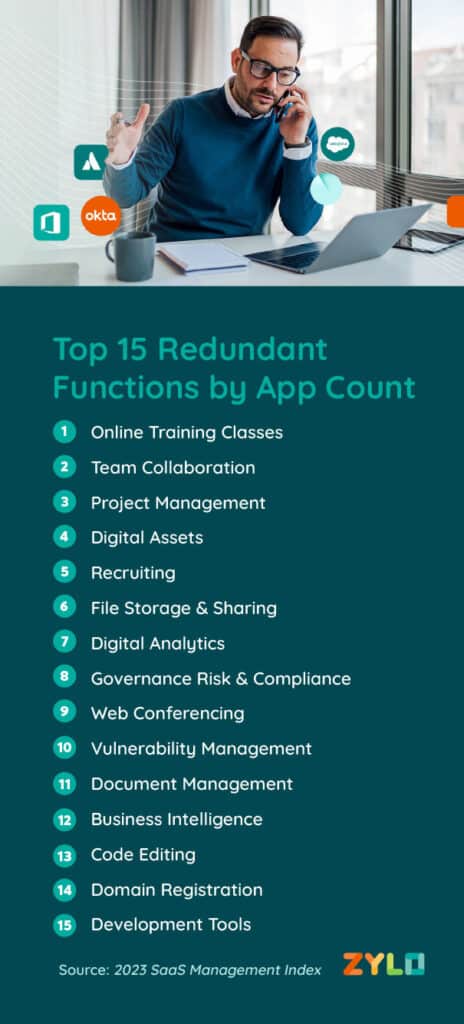 Whether you’re approaching it from the perspective of productivity or cost, duplicate apps are a nightmare. Software redundancy breeds inefficiencies within the business and removing them can help make the most of your investments and boost your effectiveness.
Whether you’re approaching it from the perspective of productivity or cost, duplicate apps are a nightmare. Software redundancy breeds inefficiencies within the business and removing them can help make the most of your investments and boost your effectiveness.
While redundant applications can and do happen anywhere, we find that the top five most abundant functions for them are:
The average organization has 200 renewals each year. With only 260 workdays in a year, that means companies are renewing applications on a nearly daily basis. Consolidating apps can get you better contract terms and increase the power you have at the time of renewal.
Several elements of SaaS optimization contribute to this. The main three include:
Companies often swing between an iron-tight hold and a completely open process for procurement. Optimization means finding the sweet spot between enough variety and a set amount of tools for employees.
Finding this balance improves the collaborative spirit in a company and encourages team-building.
Take a look at our example of how this looks when it comes to marketing and IT collaboration. As you’ll see, working together to optimize and collaborate can help drive more value and allow teams to get the most out of their software and investment.
READ MORE: Top 5 Most Utilized SaaS Applications
With the knowledge of where you are and what you have, you can begin preparing better for the future. Knowing that it’s optimized can help to make sure that you aren’t wasting any time or money as you prepare for the future.
Visibility into what you’re currently spending enables better decisions when it’s time for new purchases, updating contract terms, and adding new licenses. From here, businesses can decide what to keep, what to discard, and what to invest more in. Without this knowledge, it’s impossible to forecast the future.
What needs will your team have? Zylo helps forecast software usage and needs to create a SaaS budget forecast accurately and with ease.
We’ve spent a lot of time on the benefits of SaaS optimization but what are the risks of failing to do so?
Gartner expects that companies without a tool to centrally manage and optimize SaaS will overspend by 25% over the next couple years. Old-school spreadsheets might work at the beginning, but add in more than a few applications and they quickly become obsolete.
Zylo finds ALL of your SaaS and recommends areas of improvement based on your specific data. This includes highlighting opportunities and priorities to make optimization easy.
Ever hear of the phrase “throwing good money after bad?” Companies that don’t optimize their SaaS may result in the underutilization of as much as 53% of their platforms. Meaning they keep throwing money away from over-provisioned, unused, and underused licenses.
Instead of wasting money on these problems, Zylo immediately highlights areas of improvement. Once you have found that unneeded 53% of your applications, you can cut them out completely.
Why pay for the premium license when a free or low-cost license will suffice?
When companies permit multiple teams to purchase software on their own, SaaS growth can become unmanageable. In the old days, a single gatekeeper could be responsible for blocking purchases that aren’t needed. Today, it’s almost impossible to stand in the way of this.
Along with the uncontrolled growth of applications comes runaway costs and risks, duplicative purchases, and unused/underused tools. All of which could reduce purchasing and negotiation power over time, creating inefficiencies among your teams.
The first consideration when thinking of how to optimize SaaS stack should be the goals you have for your specific situation. Depending on your goals, the right course of action will differ wildly.
Broadly speaking, there are five different levers that companies can pull to adjust spend and usage. These are:
Software rationalization, or application rationalization, refers to determining which software or applications you can replace, reduce, or eliminate.
It is common for businesses to discover they have duplicate or redundant SaaS subscriptions. Automatic renewals and increased access for staff can lead to a bloated portfolio and excessive payments. Companies with duplicate subscriptions pay multiple times for the same tool whereas redundant applications mean paying for two subscriptions for a similar function.
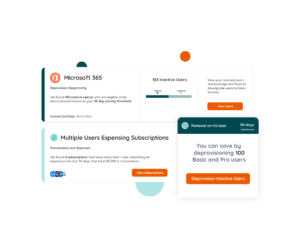
With both of these common concerns, companies overpay unknowingly ad infinitum. The only way to break the cycle is to first discover the cycle you’re in. Businesses must measure SaaS value consistently.
Say a company buys 100 seats for a project collaboration application. They do this through Accounts Payable or a direct supplier purchase. Then, an employee purchases the same application using a credit card and files an expense report for reimbursement.
These two payments for the same product will continue to drain the company’s finances until the company discovers it and cancels one of them. Consolidating duplicate subscriptions for the same tool enables you to improve your purchasing power and ultimately negotiate for a better deal.
SaaS discovery is the only way to prevent and understand how to reduce redundant applications. This cost often continues under the radar of most IT teams as they are not focused on employee reimbursements.
Subscription costs – whether they’re $89/month or $599/year – quickly add up. Executives must consider the implications of their redundant and duplicate SaaS.
How the Zylo Discovery Engine Powers the Most Comprehensive SaaS Management Platform
Learn MoreIf this lever seems right for your business, the following steps are the way to utilize it:
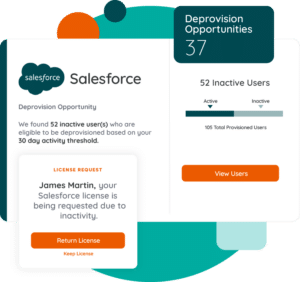 Rightsizing involves reducing your application licenses to the correct size for your actual use. This involves cutting down on wasted applications as well as unused, underutilized, or over-provisioned SaaS licenses.
Rightsizing involves reducing your application licenses to the correct size for your actual use. This involves cutting down on wasted applications as well as unused, underutilized, or over-provisioned SaaS licenses.
Rightsizing might be the right move for you if your application usage rate is below the recommended 90%. Say, for example, you provide Salesforce licenses to the entire marketing team (10 employees.) These licenses range in price but start at $25 per user, per month.
If two members of your team aren’t utilizing their license, your utilization rate would put your usage rate at 80%. While 90% is the goal, the less money you waste each month, the better.
Another example of this would be an application like Zoom. On this platform, there is a free option that fulfills the needs of many of its users. If you have employees that are using their Zoom license but could just as easily move forward with a free plan, that also means you are not optimizing your SaaS.
If you want to right size your cloud or SaaS licenses, there are a few ways that you can address it. Here’s the process for utilizing this lever:
When it comes to de-provisioning, reassigning, and eliminating licenses, we always recommend automation. It makes the process much easier and more reliable through a streamlined experience for employees.
Thanks to Cloud-Based Software License Management tools like Zylo, businesses now have the tools necessary to manage this all instantly from anywhere. Want some additional insight on how to manage saas licenses and users for some of the biggest culprits? Here are a few more resources for you:
ModMed Drives Operational Excellence & Million-Dollar Savings with Zylo SaaS License Management
Discover how ModMed used Zylo’s powerful license tracking and optimization to save millions of dollars, drive operational excellence, and improve the employee experience.
Maximizing your SaaS spend is all about finding ways to save money and maximize the investment you are making in SaaS.
You may find yourself in need of adjusting this if:
These are a few of the red flags companies should look for when they are evaluating SaaS spend. If you find yourself in this position, you likely need to reduce SaaS costs. Luckily, you are not alone and there are several tools to assist in SaaS Spend Management.
Guide to Managing SaaS Costs
Learn MoreManaging SaaS costs is important for every business across all industries. While some companies may utilize more SaaS than others, almost everyone has some fat they can trim. When evaluating your SaaS spend optimization it is best to first start with your quick wins.
These include applications with the highest cost, which also offer the greatest opportunity for cost savings. Mission-critical tools across your organization are another great place to begin your evaluation process to find these opportunities. This include-commerce platforms, CRMs, ERPs, and other comprehensive office tool suites.
Other cloud cost management tactics include:
Shadow IT isn’t always bad but not understanding where it’s at almost always leaves a financial burden on companies. Understand where all your SaaS purchases are coming from and put a SaaS governance framework in place to reduce risk and compliance issues.
Consider doing this if you don’t have a current process in place for application purchases or if employees are purchasing their own tools. Both of these can lead to security and financial risks from a sheer lack of visibility.
For starters, implementing any or all of the above levers will impact this one directly as well. The majority of our discussion thus far fits into the category of hygiene for your SaaS portfolio.
Once you have reached a place where you are confident in the portfolio of applications you utilize, the next step is to maintain it. To do this, you must place a governance strategy into practice.
These strategies vary from business to business and range from hands-on control of every purchase to free reign among the employees. Our recommendation falls in between the extremes. We call this Freedom within a Framework.
With this strategy, businesses vet platforms and negotiate with them beforehand to provide a catalog of options to employees. Ultimately this allows them to choose the tool that works best for them while empowering you to control and maintain the subscriptions of the company.
Evolving Your SaaS Governance Framework for the Digital Workplace
Learn MoreIt is impossible to begin optimizing your SaaS portfolio without first going through a process of discovery. SaaS discovery refers to the uncovering of all of your applications and subscriptions. It’s a way of mapping out your current location so that you can begin plotting a route forward.
Here is where Zylo provides a tremendous amount of benefit for companies. Zylo brings a multitude of different data points together in a single, unified system. In doing so, SaaS discovery is something that happens instantly and continuously.
There are three differentiating factors with Zylo. These are:
Software application integrations fuel the Discovery Engine, but the usage data gleaned is also what powers Zylo Insights. With our Insights tool, you don’t have to sift through all of the data on your own. We will provide you with highlights of the optimization opportunities along with how pressing they are.
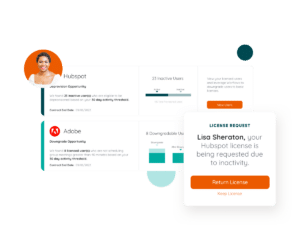
In doing so, we help to build your roadmap for optimization so you can begin delivering that value back to the business. In moments, information that would normally take hours of work organizes itself through our algorithms to present as actionable steps.
The best thing about Zylo is that we offer a tremendous amount of integrations to seamlessly fit in with your current workflow. Artificial intelligence gathers and communicates this data in two main categories:
SaaS benchmarking is a helpful way to understand how your portfolio, applications, and spend compare to companies like yours. Its insights are useful in showing opportunities to rightsize and rationalize your applications. Additionally, this data works to your benefit when it’s time to negotiate better pricing for renewals.
On average, Zylo Benchmarks finds companies overspend by 15% on software licenses. This part of the platform seeks to rectify that by enabling companies to compare their applications with their peers.

While everyone would like to believe they are getting a good deal on their platforms, it’s impossible to know without a comparison. With Zylo Benchmarks, you can filter and compare by category, subcategory, and even functionality on each application.
Harness this information to assess your annual spend and the total number of applications you use to others in your same field. In addition to this, these insights can show areas your peers are taking advantage of that you may be forgetting.
See the top applications as they pertain to any specific need along with how they stack up against similar tool options.
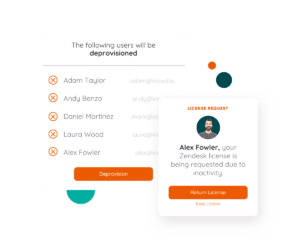 Managing the various licenses of a business can feel like juggling a bunch of objects of different weights and sizes. Some renew monthly, quarterly, or annually and, depending on the option, some renew automatically, billing to various parts of your organization.
Managing the various licenses of a business can feel like juggling a bunch of objects of different weights and sizes. Some renew monthly, quarterly, or annually and, depending on the option, some renew automatically, billing to various parts of your organization.
Automation makes it easy to take action on SaaS optimization. Through Zylo’s License Management Workflow, IT leaders gain:
Automated workflows handle the tedious nature of day-to-day tasks in more efficient and more reliable ways than humans ever could.
Software is your business’s second largest operating expense and opportunities to save are abundant. However, with hundreds of decentralized SaaS applications, it’s hard to know where to start, what to prioritize, or how to measure the financial impact of managing and optimizing your stack.
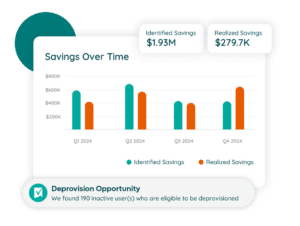 Zylo’s Savings Center not only makes the ROI of a SaaS Management program quantifiable, it is the central location for IT, SAM, and Procurement to manage their activities that lead to savings. Drive meaningful results for your organization while looking like a savings superhero to your boss!
Zylo’s Savings Center not only makes the ROI of a SaaS Management program quantifiable, it is the central location for IT, SAM, and Procurement to manage their activities that lead to savings. Drive meaningful results for your organization while looking like a savings superhero to your boss!
The optimization of your company’s SaaS is vital to a smooth operation. Companies invest large amounts of money into the tools and applications they provide. If this steep investment is not seeing a return, it’s important to know that as soon as possible.
Unfortunately, the positives of the decentralization of SaaS procurement in companies also carry the negative weight of decreased visibility. It’s hard to know exactly what your company is paying for on those recurring monthly bills.
Each of the levers we focused on comes back to this issue of discovery.
Zylo operates as a SaaS Discovery Engine that can instantly and continuously find, track, and monitor your SaaS usage. Gain fast, reliable information on your team, your applications, and your competition.

Table of Contents ToggleWhy SaaS Optimization Is Important Companies Spend a Lot...

Table of Contents ToggleWhy SaaS Optimization Is Important Companies Spend a Lot...

Table of Contents ToggleWhy SaaS Optimization Is Important Companies Spend a Lot...

Table of Contents ToggleWhy SaaS Optimization Is Important Companies Spend a Lot...

Table of Contents ToggleWhy SaaS Optimization Is Important Companies Spend a Lot...

Table of Contents ToggleWhy SaaS Optimization Is Important Companies Spend a Lot...

Table of Contents ToggleWhy SaaS Optimization Is Important Companies Spend a Lot...

Table of Contents ToggleWhy SaaS Optimization Is Important Companies Spend a Lot...

Table of Contents ToggleWhy SaaS Optimization Is Important Companies Spend a Lot...

Table of Contents ToggleWhy SaaS Optimization Is Important Companies Spend a Lot...
| Cookie | Duration | Description |
|---|---|---|
| cookielawinfo-checkbox-analytics | 11 months | This cookie is set by GDPR Cookie Consent plugin. The cookie is used to store the user consent for the cookies in the category "Analytics". |
| cookielawinfo-checkbox-functional | 11 months | The cookie is set by GDPR cookie consent to record the user consent for the cookies in the category "Functional". |
| cookielawinfo-checkbox-necessary | 11 months | This cookie is set by GDPR Cookie Consent plugin. The cookies is used to store the user consent for the cookies in the category "Necessary". |
| cookielawinfo-checkbox-others | 11 months | This cookie is set by GDPR Cookie Consent plugin. The cookie is used to store the user consent for the cookies in the category "Other. |
| cookielawinfo-checkbox-performance | 11 months | This cookie is set by GDPR Cookie Consent plugin. The cookie is used to store the user consent for the cookies in the category "Performance". |
| viewed_cookie_policy | 11 months | The cookie is set by the GDPR Cookie Consent plugin and is used to store whether or not user has consented to the use of cookies. It does not store any personal data. |
